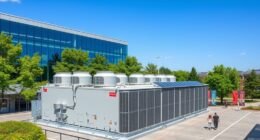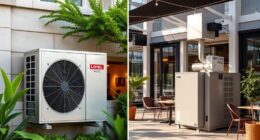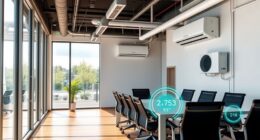We have discovered the key to unlocking the full potential of commercial heat pump systems.
In this article, we delve into the intricacies of these systems, providing you with the knowledge needed to make informed decisions.
From understanding energy efficiency ratings to optimizing performance, we’ll guide you through every step of the process.
So, let’s embark on this journey together and decode the secrets to effective commercial heat pump systems.

Key Takeaways
- Efficient commercial heat pump systems optimize energy usage and reduce wastage in commercial properties.
- The key components of an effective commercial heat pump system include the compressor, heat exchanger, expansion valve, evaporator coil, and condenser coil.
- Energy efficiency ratings, such as COP and EER, provide information about performance and cost savings potential.
- Proper sizing and installation, as well as regular maintenance, are essential for maximizing the performance and energy efficiency of commercial heat pump systems.
The Importance of Efficient Heat Pump Systems for Commercial Properties
We believe that efficient heat pump systems are crucial for commercial properties. These systems offer a range of energy-saving benefits and cost-effective solutions, making them an indispensable asset.
When it comes to energy consumption, commercial properties are notorious for their high demands. This is where efficient heat pump systems come into play, as they optimize energy usage and reduce wastage. By utilizing advanced technology, these systems efficiently transfer heat from one location to another, resulting in significant energy savings.
Furthermore, the cost-effective nature of these systems ensures that commercial property owners can maximize their return on investment. With rising energy costs and an increasing focus on sustainability, it’s imperative for commercial properties to embrace efficient heat pump systems to meet their energy needs while reducing their carbon footprint.
Key Components of an Effective Commercial Heat Pump System
To ensure optimal performance, an effective commercial heat pump system requires the integration of key components and the coordination of their functions. These components play a crucial role in enhancing system efficiency and providing reliable heating and cooling for commercial properties.

Here are the key components that contribute to the effectiveness of a commercial heat pump system:
- Compressor: Responsible for compressing the refrigerant and maintaining the pressure needed for heat transfer.
- Heat exchanger: Facilitates the transfer of heat between the refrigerant and the air or water in the surrounding environment.
- Expansion valve: Controls the flow of refrigerant and regulates its pressure, ensuring efficient heat exchange.
- Evaporator coil: Helps to absorb heat from the indoor air or water, allowing for effective cooling or heating.
- Condenser coil: Releases heat to the outdoor air or water, completing the heat transfer process.
These components work together seamlessly, maximizing system efficiency and providing optimal comfort for commercial spaces.
Understanding the Energy Efficiency Ratings of Commercial Heat Pumps
Commercial heat pumps are rated for energy efficiency using a standardized system. These ratings provide valuable information about their performance and cost savings potential.
Understanding the energy efficiency ratings of commercial heat pumps is essential for businesses looking to optimize their heating and cooling systems. Energy efficiency standards for heat pumps are measured using a coefficient of performance (COP) or an energy efficiency ratio (EER).

COP measures the ratio of heat output to electrical input, while EER measures the cooling capacity of the heat pump divided by its power consumption. Higher COP and EER ratings indicate greater energy efficiency and cost savings.
Best Practices for Sizing and Installing Heat Pumps in Commercial Buildings
When it comes to sizing heat pumps for commercial buildings, it’s crucial to ensure proper sizing in order to achieve optimal performance and energy efficiency.
Factors such as building size, insulation, and climate must be taken into account to determine the appropriate heat pump capacity.
Additionally, the installation process should be carefully executed to maximize the heat pump’s efficiency and energy savings.

Proper Heat Pump Sizing
We typically recommend using a sizing factor of 1.5 to accurately determine the appropriate heat pump size for commercial buildings. This factor takes into account various factors such as the building’s size, insulation, and climate conditions. Proper heat pump sizing is crucial for achieving optimal performance and energy efficiency.
Here are some best practices for sizing and installing heat pumps in commercial buildings:
- Conduct a thorough heat load calculation to determine the heating and cooling requirements of the building.
- Consider the building’s occupancy and usage patterns to ensure the heat pump can handle the demand.
- Take into account any future expansions or changes in the building’s usage to avoid undersizing the heat pump.
- Consult with a professional HVAC contractor who’s experience in commercial heat pump installation.
Regular heat pump maintenance is essential to ensure its longevity and efficiency. Schedule regular inspections, cleanings, and repairs to prevent any issues.
Installation Considerations for Heat Pumps
To ensure optimal performance and energy efficiency, our team recommends following best practices when sizing and installing heat pumps in commercial buildings.

Proper installation techniques are crucial for the long-term functionality of the system. First, selecting the right location for the heat pump is essential. It should be placed in a well-ventilated area with sufficient clearance for maintenance procedures. The heat pump should also be installed on a stable surface to minimize vibration and noise.
Additionally, proper sizing of the heat pump is crucial to ensure it can effectively meet the heating and cooling demands of the building. Oversized or undersized heat pumps can result in inefficiencies and increased energy consumption.
Lastly, regular maintenance procedures, such as cleaning the filters and coils, checking refrigerant levels, and inspecting electrical connections, should be performed to keep the heat pump operating at its best.
Following these installation considerations and maintenance procedures will help maximize the performance and lifespan of commercial heat pump systems.

Efficiency and Energy Savings
For optimal efficiency and energy savings, our team recommends implementing best practices in sizing and installing heat pumps in commercial buildings. By following these guidelines, you can significantly reduce energy consumption and minimize the environmental impact of your operations:
- Properly size the heat pump system to match the building’s heating and cooling load.
- Ensure proper insulation and weather sealing to prevent heat loss or gain.
- Optimize the ductwork design to minimize air leakage and maximize airflow.
- Regularly maintain and inspect the heat pump system to ensure optimal performance.
- Utilize smart controls and advanced monitoring systems to optimize energy usage and identify potential issues.
Implementing these best practices won’t only result in significant energy savings but also contribute to a greener and more sustainable future.
In the next section, we’ll discuss how to further optimize heat pump performance for commercial applications.
Optimizing Heat Pump Performance for Commercial Applications
Our goal is to maximize the performance of heat pump systems in commercial applications.

Optimizing heat pump performance is crucial for improving energy efficiency and reducing operating costs.
One way to achieve this is by implementing energy-saving solutions such as variable speed drives and advanced control systems.
Variable speed drives allow the heat pump to adjust its speed based on the heating or cooling demand, resulting in significant energy savings.
Advanced control systems, on the other hand, optimize the heat pump’s operation by continuously monitoring and adjusting various parameters, such as temperature, pressure, and airflow.

Maintenance and Troubleshooting Tips for Commercial Heat Pump Systems
As professionals in the field of commercial heat pump systems, we understand the importance of regular maintenance to ensure optimal performance.
A preventive maintenance checklist can help us identify potential issues before they become major problems, allowing us to address them promptly.
Additionally, we need to be prepared for common troubleshooting issues and employ efficient techniques to diagnose and resolve them effectively.
Preventive Maintenance Checklist
We will provide a 10-point preventive maintenance checklist for ensuring the optimal performance of commercial heat pump systems.

-
Regular maintenance schedule: Implement a routine maintenance schedule to ensure timely inspections and upkeep of the heat pump system.
-
Equipment inspection: Conduct thorough inspections of all components, including the compressor, condenser, evaporator, and refrigerant lines.
-
Cleaning and lubrication: Clean and lubricate all moving parts to enhance efficiency and prevent wear and tear.
-
Air filter replacement: Regularly replace air filters to maintain proper airflow and prevent dust and debris buildup.

-
Electrical connections: Check and tighten all electrical connections to prevent any potential hazards or performance issues.
These preventive maintenance measures are essential for maintaining the longevity and efficiency of commercial heat pump systems.
Common Troubleshooting Issues
Let’s address the common troubleshooting issues that may arise with commercial heat pump systems and provide maintenance and troubleshooting tips to resolve them.
When it comes to troubleshooting commercial heat pump systems, it’s essential to have a good understanding of the common issues that can occur.

One common issue is a loss of heating or cooling capacity. This can be due to a variety of factors such as refrigerant leaks, faulty thermostats, or clogged filters. To resolve this, it’s important to check for any leaks, replace faulty thermostats, and clean or replace filters regularly.
Another common issue is inadequate airflow, which can lead to reduced efficiency and performance. This can be caused by blocked or dirty air ducts, malfunctioning fans, or improper installation. Troubleshooting techniques for this issue include cleaning air ducts, replacing fans if necessary, and ensuring proper installation.
Efficient Troubleshooting Techniques
Our maintenance and troubleshooting tips for commercial heat pump systems will help ensure efficient troubleshooting techniques. To effectively maintain and troubleshoot these systems, here are some important techniques to keep in mind:
- Regularly clean and inspect the heat pump components to prevent dirt buildup and ensure optimal performance.
- Monitor and adjust the thermostat settings to avoid unnecessary strain on the system.
- Check for refrigerant leaks and ensure proper refrigerant levels to maintain efficient operation.
- Inspect the electrical connections and components for any signs of wear or damage.
- Keep the outdoor unit clear of debris and vegetation to facilitate proper airflow.
Frequently Asked Questions
Are Heat Pump Systems Suitable for All Types of Commercial Properties?
Heat pump systems have advantages for most commercial properties, but cost considerations must be taken into account. We analyze the suitability of heat pump systems for different types of commercial properties without considering the context of Decoding Effective Commercial Heat Pump Systems.

What Are the Potential Drawbacks or Limitations of Using Heat Pump Systems in Commercial Buildings?
There are potential challenges and limitations to using heat pump systems in commercial buildings. These include higher upfront costs, limited heating capacity in extreme cold climates, and the need for regular maintenance to maintain energy efficiency.
How Can I Determine the Appropriate Size of a Heat Pump System for My Specific Commercial Building?
To determine the appropriate size of a heat pump system for our specific commercial building, we should consider sizing considerations and energy efficiency. These factors will help us ensure optimal performance and cost-effectiveness.
What Are Some Common Maintenance Tasks That Need to Be Performed on Commercial Heat Pump Systems?
Some common maintenance tasks for commercial heat pump systems include regular filter cleaning, inspection of electrical connections, checking refrigerant levels, and lubricating moving parts. Troubleshooting tips may involve identifying and fixing leaks or addressing issues with airflow and temperature control.
Are There Any Specific Troubleshooting Tips for Addressing Common Issues With Commercial Heat Pump Systems?
When troubleshooting common issues with commercial heat pump systems, we rely on our expertise and a range of techniques. By analyzing performance, checking for leaks, and ensuring proper airflow, we efficiently identify and resolve problems.

Conclusion
In conclusion, effective commercial heat pump systems play a crucial role in improving energy efficiency and reducing operational costs in commercial properties.
One interesting statistic to consider is that according to a recent study, commercial buildings that have implemented efficient heat pump systems have witnessed an average energy savings of up to 30%.
This highlights the significance of investing in high-quality heat pump systems to optimize energy usage and enhance overall performance in commercial applications.








